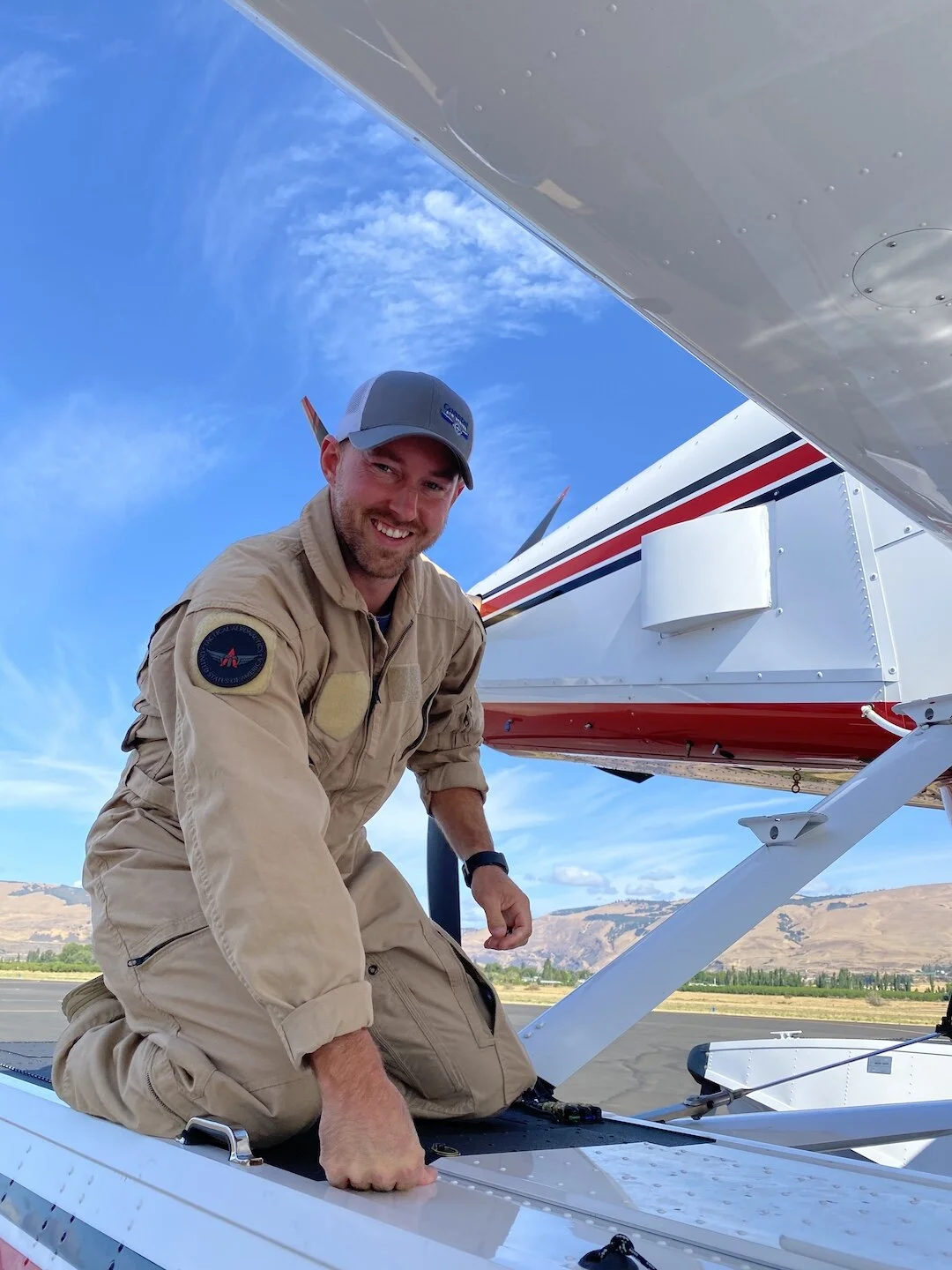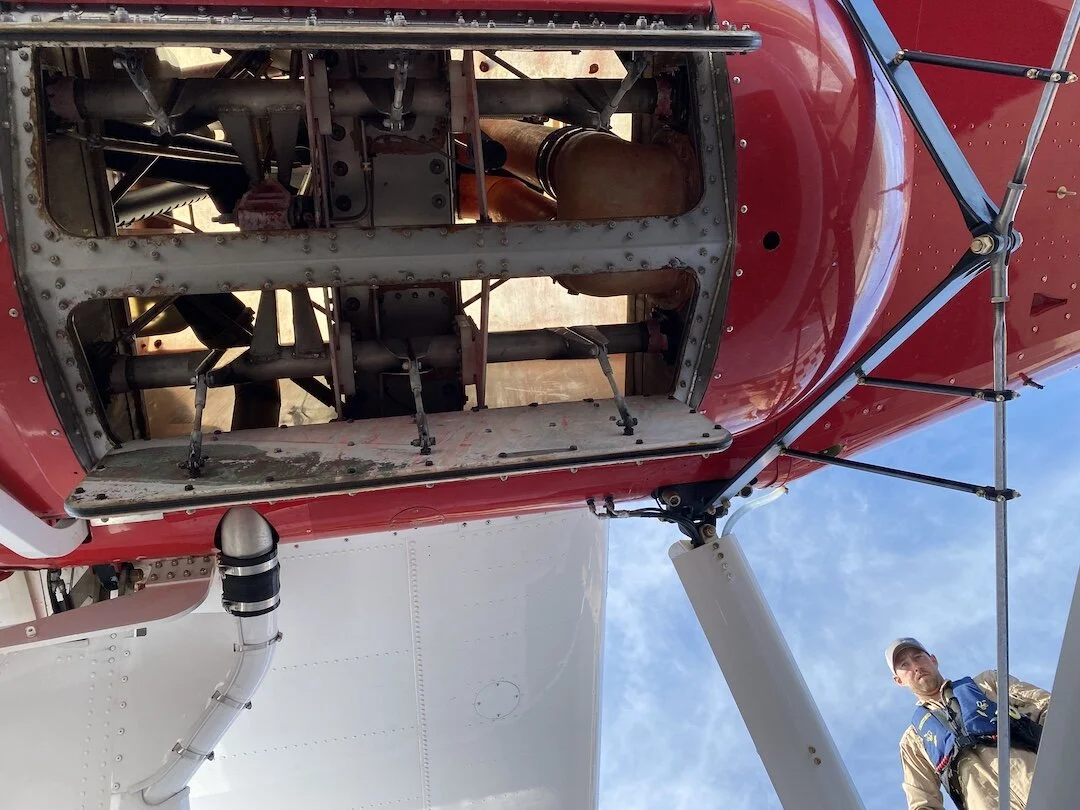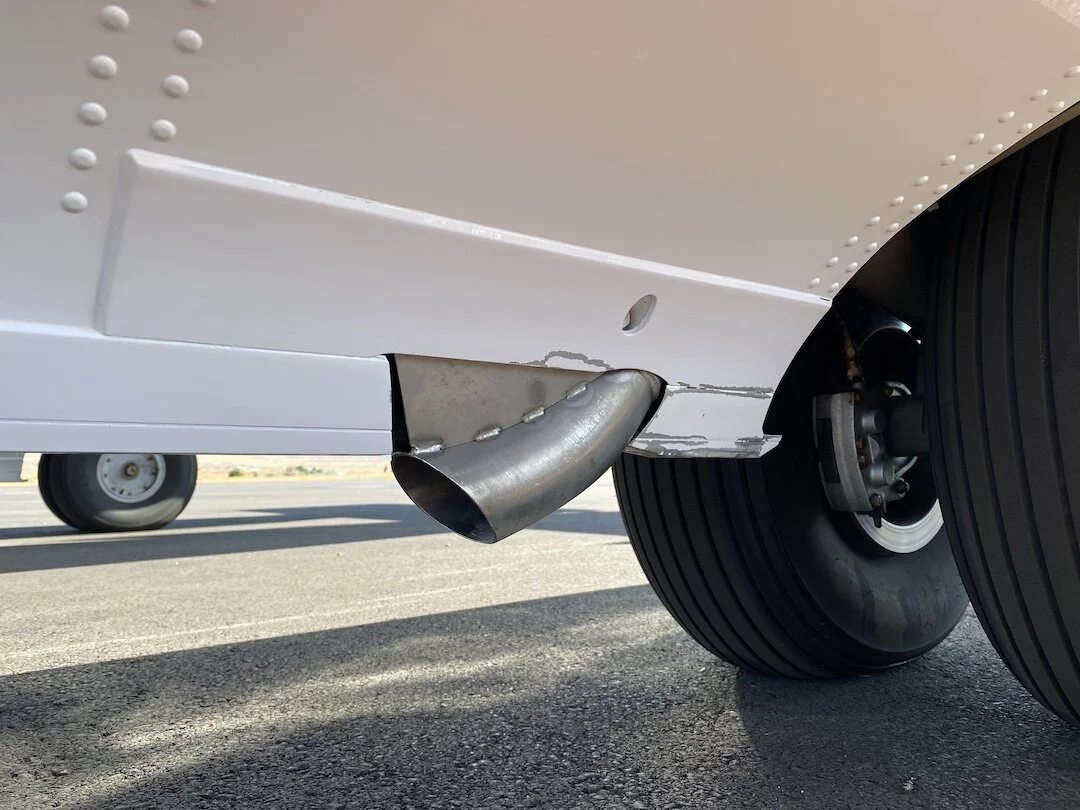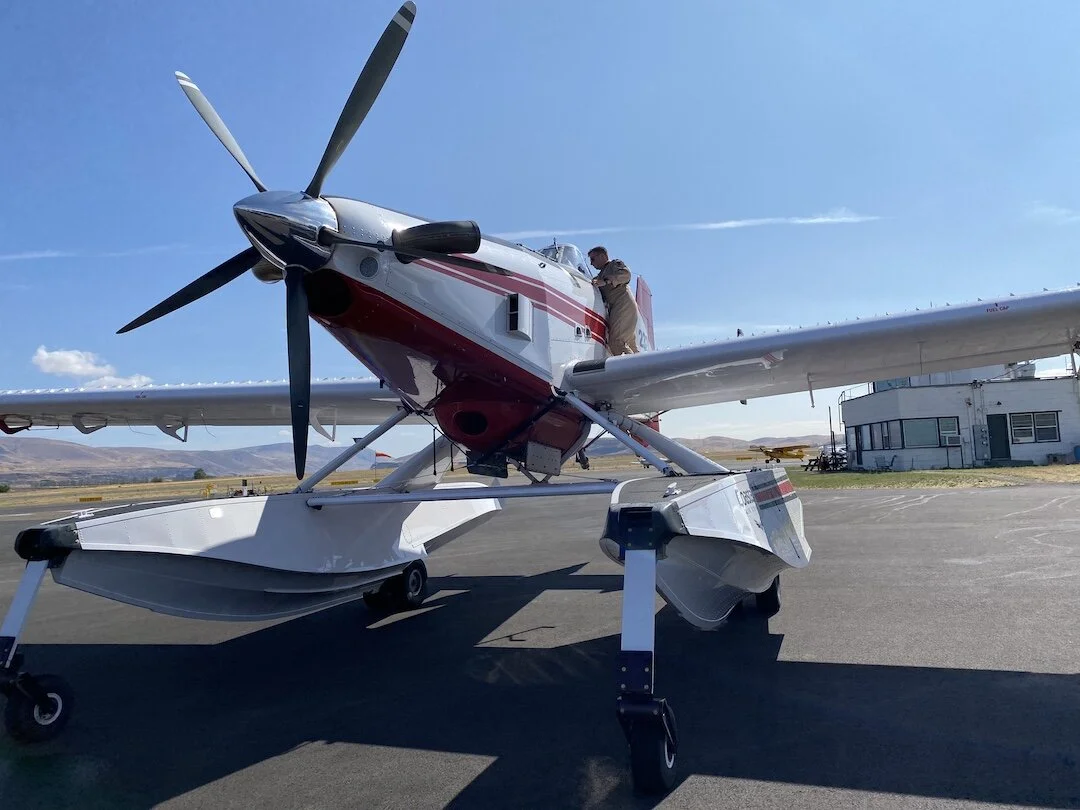Fire Boss a Game Changer in Gorge; Unflappable Pilots prove their worth
Colby Smith readying for flight on his Fire Boss AT 802F. He and Chief Pilot Vince Aaron saw a lot of action this summer in the Gorge. They also helped give ground crews an upper hand on blazes that were thwarted in days instead of weeks.
Grab the stick and take this Fire Boss for a 60 mile per hour ride across the Columbia River to pick up your water, then drop into a fire like a crop duster.
By Tom Peterson
Thirty-one-year-old Colby Smith was aloft in a Fire Boss scooper plane, its 1600 horsepower turbine engine screaming behind the prop on the afternoon of July 1st.
Smith, who cut his teeth on crop dusting, was flying near Wishram. Chief Pilot Aaron Vince was also buzzing through the area.
That’s when Smith noticed smoke on the Oregon side of the Columbia River, east of The Dalles.
Flames were climbing toward a home on Valley View Drive.
Smith was the first to spot the fire. He was the first on the scene, and he was carrying 600 gallons of water to douse the blaze.
It was a quick strike, and he and Vince were able to put thousands of gallons per hour on the fire as ground crews got to the scene and started calling for additional airstrikes as it burned through 1,000 acres.
The Fire Boss and their pilots are giving firefighters a strategic advantage as the converted crop dusters can quickly respond and pummel flames through scooping water on the Columbia River. They are quickly becoming a fan favorite for government agencies looking to out blazes before they get too big.
Mid-Columbia Fire and Rescue Chief Robert Palmer would later point out the advantage.
“Without the resources we had today, including the three additional task forces and air support from the Oregon State Fire Marshal, we would not have stopped it as quickly and the fire would have grown much larger,” said Palmer. “What the state is doing is working. We were able to better protect properties with their assistance and support.”
Here’s a look at the open water tank on the Fire Boss - this is where 600 plus gallons of water drops from as pilots fly 20 feet above the smoke and flames.
The Fire Boss Planes are part of Coastal Air Strike, a company based in the small town of Roe, Arkansas, and owned by Michael Hutchins. Hutchins is also a relief pilot for the crew based in Dallesport at the Columbia Gorge Regional Airport.
The Oregon Department of Forestry contracted Coastal Air Strike for the first time this summer to provide air support in fires.
That’s a major change as prior contracts for their services were with Washington's Department of Natural Resources. It gave Oregon the first crack at the quick-striking planes.
Coastal Air Strike has a fleet of 12 planes currently as the company has grown to employ 17 pilots as they battle fire all over the country. One key to that success has been the Fire Boss and their intrepid pilots.
This photo shows the intake or scoop that goes into the river or lake that is being scooped. The water is driven into the tank located in the plane’s fuselage.
It’s “a fast-filling aircraft that can be back on the fire quicker than one that has to return to base be refilled. The FireBoss can stay on station for an entire fuel cycle, only needing a nearby water source to stay on a fire and continue drops,” according to an article in Aerialfiremag.com
Read more about it here.
Getting Behind the Stick
Hutchins, 48, Vince, 51, and Smith, 31, said they flew crop dusters for years before taking the controls of the Fire Boss AT802F.
The plane is made by Air Tractor.
Crop dusting takes the special skill of being able to dodge cars, power lines, trees, and houses while taking steep banking turns and then flying low enough to the ground to apply fertilizers, herbicides and pesticides - about 10 feet off the ground.
But with the Fire Boss, the hazards are sailboarders, kiteboarders, boats and big waves.
This is a bout how high the water comes on the Fire Boss float as pilots scoop water from the Columbia at 60 miles per hour.
“Ag guys have a leg up compared to pilots coming from commercial service,” Hutchison said, on Thursday, July 26, noting many of the piloting skills for crop dusting or firefighting are similar. Steep bank turns, and flying at 10 to 20 feet above the ground are inherent in both.
Don’t underestimate that low altitude.
There is little room for error. A stall in a plane at 10 feet off the ground, where it loses lift for lack of speed, can be deadly.
And these pilots are skimming the water at 60 miles per hour, the floats of the plane buried two to three feet deep in river or lake water.
Hydraulic rams deploy the 2-inch intakes from the floats or pontoons and 600 gallons of water is forced into the water tank in the fuselage of the plane in 10 seconds.
Water is heavy.
The plane takes on 5,000 pounds in 10 seconds, so pilots have to increase the torque of the turbine engine to meet the energy needs to keep the plane flying at speed to prevent a stall. All the while, a firm grip on the stick is necessary to keep the plane in the exact right position to draft the water.
“The balancing act never gets dull,” Smith said.
Michael Hutchins, pilot and owner of Coastal Air Strike, readies his plane in Dallesport at the Columbia Gorge Regional Airport. He and pilot Colby Smith, of Arkansas, provided training to the Oregon Department of Forestry on Thursday, July 26. The training provided ground crew fire fighters insight on how the planes operate as well as their capabilities.
A Little Satisfaction
Vince, who has flown other single-engine airtankers that have to be filled while stationed on the ground, said the challenge of flying the Fire Boss was a bit addicting.
“It gives you a different attack on the fire,” he said, noting other planes are using retardant in attempts to build a line around the fire to contain it.
“This is more aggressive,” he said, agreeing it was satisfying to douse the head of a fire and see the immediate effect of a well-placed water drop.
He said the planes were great for stopping the advancement of a blaze because they can also douse hot spots where wind-blown embers ignite another fire far from the original.
Big Capacity
Pilots can get about 3/12 hours of flight time out of a single tank of 380 gallons of fuel with the Fire Boss. They can dump more than a dozen loads in an hour's time. Air Tractor states the planes are capable of dropping 14,000 gallons of water per hour. Of course, that amount depends strictly on the distance between the water source and the location of the fire.
Pilots are allowed to fly 8-hours per day. They typically get a break while refueling for about 30 minutes.
It’s difficult work that requires intense concentration and a level mind.
Lighting up the Sky
Back on Aug. 5th, a storm cell was brewing northeast of Dallesport, sending hundreds of lightning strikes to the ground.
At around 3 p.m., two white lights could be seen flying under the black clouds and lightning strikes. It was Vince and Smith coming off a fire.
Vince said that raised his hackles. They made it through safely, but he noted that planes can be hit with lightning, and it can put holes in the fuselage or fry radio stacks.
Tool Time
“It’s another tool in the box,” Vince said of the Fire Boss.
And one that is getting used more and more by public agencies due to its quick-strike ability.
The number of companies offering the services around the country has doubled to four in the last year Vince said.
The Oregon Department of Forestry likes what they are seeing from the planes.
“Overall, it's a great tool specifically for this area,” said Oregon Department of Forestry’s Kiel Nairns. Nairn is the Wildland Fire Supervisor, stationed in The Dalles. “They have great maneuverability for the Gorge and other terrains and are excellent at getting down and knocking out flames on actual fires. They have a quick turnaround, maximizing drops on fires… they do laps. It’s especially handy because of the wind here. We can get a jump on fires especially in these light fuels (grass, wheat crops) that go so fast.”
Nairn said their ability to position the planes at small airports around the state - they only need 3,000 feet to take off when loaded - gives them the advantage of being close and hitting a fire when it's still small. The planes are often shared on different fires. Rural fire departments, US Forest Service and other agencies have all used the Fire Boss planes this summer in the Gorge, creating an efficient use of a shared resource. Fire Boss Pilots out of The Dalles fought fires in the Tillamook State Forest and another blaze near Forest Grove this summer, dipping out of Hagg Lake.
Agencies share in the cost for using the planes, Nairn said.
“They’ve been a great addition,” Nairn said, noting it was likely they would be here for the next fire season if budgets hold.
Put it out, NOW.
The planes provide a more aggressive strategy, Kairns said, noting the quick strikes can prevent small fires from growing into large conflagrations.
And that saves money.
Nairn said thousands spent on planes that stop a fire quickly can save millions of dollars in the long run.
It’s also safer to put a fire out early. It decreases the number of firefighters it takes to battle a blaze and the overall number of hours firefighters are exposed to hazardous conditions, he said.
“In general, the air assets focus on the head of fire or advancing part of it as our crews advance on the fuel of the fire,” he said. “In that sense, we’re not putting folks in the intense part of the fire behavior.”






